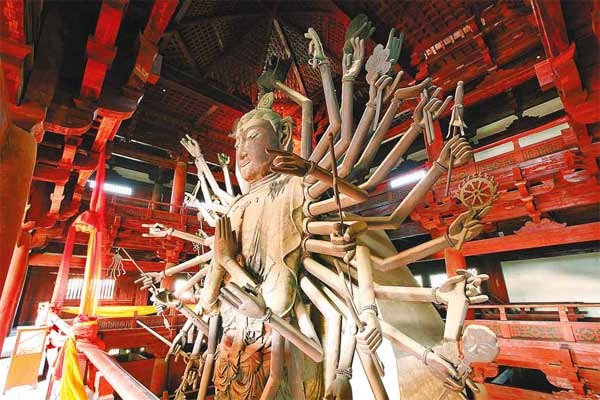
The Thousand Hands, Thousand Eyes Buddha is the biggest draw at Longxing Monastery in Shijiazhuang. Photo: China Daily
Modern visitors to the ancient town of Zhengding discover Longxing's Big Buddha is an exceptional figure — but ultimately an idiosyncratic entity that dwells in a settlement packed with peculiarities.
What has nine heads, 42 arms and is 21 meters tall?
The answer isn't the punch line to a lame joke but rather the incredible statue that gives the Longxing Monastery its other appellation — the Big Buddha Temple.
The country's largest bronze Buddha is also known as the Thousand Hands, Thousand Eyes Buddha — a misnomer by virtue of exaggeration but a namesake that nonetheless hails its uniqueness. The Song Dynasty (AD 971) statue's bronze arms were destroyed in 1780 but later restored by believers.
Yet the sculpture is only one of myriad religious rarities housed by the holy site in Hebei province's ancient Zhengding city (then the province's capital), about 15 km outside the provincial capital Shijiazhuang.
Longxing ranks among the country's best-preserved temples because it was a stopover for emperors undertaking pilgrimages to the Wutai Mountains, giving the compound yet another title — the First Temple South of Beijing.
That's perhaps the reason it hosts so many sacred peculiarities.
An amazing trove of artifacts survived from Longxing's construction in the Sui Dynasty (AD 581-618), especially those from after the Song revamped the compound. One of the oldest surviving artifacts is the Longcang Temple Stele, hailed as "the First Stele of the Sui Dynasty". It's actually China's oldest.
An especially striking specimen from the period immediately following the reconstruction is a 10.8-meter octagonal rotating sutra bookshelf that's 7 meters in diameter. It's the oldest and largest of a handful that remains and offers insight into Song technology.
A 1,000-year-old 7.4-meter-tall Buddha carved from a single tree is unique in that it's exceptionally slender and stands rather than sits.
Another celebrated sculpture is unparalleled in that it depicts "China's most beautiful Guanyin" at her "most casual". The Goddess of Mercy reclines whimsically in stark contrast to her otherwise rigid depictions in the only known such rendering in dynastic history.
But there's a potentially unnerving dimension of Guanyin's laidback side — her gaze seems to follow you as you walk. Some consider her wandering eyes playful. Others call them creepy.
Three stacked domes of 1,072 Buddhas — a Ming (1368-1644) emperor's gift to dear old Ma — are celebrated as some of the best bronze work from the era, mostly because of their surfaces' smoothness.
The buildings that house Longxing's rare relics are also exceptional in themselves.
Experts nominate Mahamuni Hall as the apex of ancient Chinese architecture.
The nine stairs — nine is a homonym for longevity in Chinese — exiting the hall containing the 500-year-old two-faced Buddha altar are a millennium old and haven't been restored. They're intact but slick — polished glossy by 1,000 years of ever-trickier tromping. Trees planted at about the time the stairs were carved shade them.
Also, the temple's swooping eves are meant to resemble a lion's claw from a bird's-eye view.
The town in which Longxing was constructed is also unique in that it preserves an architectural timeline of the country's development.
| Touched | Sympathetic | Bored | Angry | Amused | Sad | Happy | No comment |
Rhythm Media Group is a multi-media company, operating a US-based Chinese daily newspaper, The China Press, and the paper's website - uschinapress.com (which has mobile-app version), as well as a Beijing-based English website Sino-US.com. The group boasts 15 branch offices across the US, and a number of cultural centers focusing on culture-related business in the North America, Chinese mainland, Hong Kong and Taiwan.Launched in September 2012, the Sino-US.com is designed to serve as a bridge between China and the US, and to keep its readership inside or outside China better informed by providing news and insights on China's current affairs, culture, life, business, people and sports.